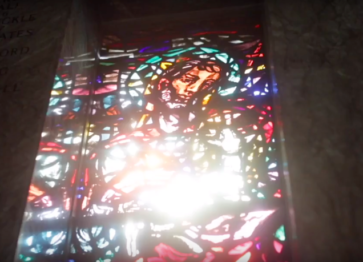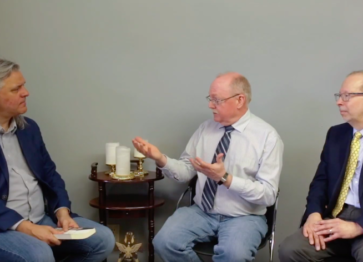[Editor’s Note: The following blog originally appeared on www.gordonlheath.com. To see the original post and others, click the above link.]
Christianity’s relationship with culture and the state has always been fluid, and developments over the past half a century have led to the rise, fall and return of Christendom in some old and new places. How those changes will impact the church’s view of war and violence is the focus of this blog.
[Note: “Christendom” is a term used to describe a church-state relationship marked by (1) the state identifying as Christian, (2) the church having a place of privilege over against other religions, (3) the church and state working in some sort of symbiotic partnership, and (4) the church being the primary shaper of culture.]
The Fall of Christendoms
Old Christendoms in the West are facing a post-Christendom future, leading to a flurry of books lamenting or celebrating the church’s move to the margins, with implications for how the state and its use of the sword is understood. The erosion of Christendom in the West has many cheerleaders. Their hope is that the collapse of the church-state relationship associated with Christendom will lead to a renaissance of a (much romanticized) pre-Constantinian pacifism.
For instance, one author states that the disestablishment of the church is “God’s gift to the church in our era,”1 another that the end of Christendom “spells the beginning of a new flowering of Christianity,”2 and yet another states that his book “celebrates the end of Christendom.”3 Douglas J. Hall writes “the end of Christendom could be the beginning of something more nearly like the church,”4 and Stanley Hauerwas and William H. Willimon declare that the decline of Christendom is an “opportunity to celebrate. The decline of the old, Constantinian synthesis between the church and the world means that we American Christians are at last free to be faithful in a way that makes being a Christian today an exciting adventure.”5
But is it really that simple?
The increasing trajectory in the West to a post-Christendom culture will certainly present new opportunities and challenges. Perhaps the “move to the margins” will enable churches to speak freely, without the traditional ties of state-church relationships to compromise the church’s willingness to be critical of government. There will also be a severing of any notions of a religious war being fought for the Christian religion.
On the other hand, a disestablished and marginalized church can be easily ignored, for at least in Christendom the church had a platform for speaking directly to heads of state and the nation.6 And what will that loss of prophetic voice mean for how wars are waged? Will rulers feel at liberty to wage war without constraint?
The basic assumption that being on the margins makes a Christian witness easier or less prone to compromise is also faulty. Christians facing issues related to war and violence face vexingly complex issues. Being outside of Christendom does not change that. In fact, a church on the margins can fall to the temptation to dull its prophetic voice during wartime in order to receive concessions or protection from a hostile government. It may also be tempted into making bad alliances for protection, the “enemy of my enemy is my friend” type.7
Finally, the breakup of Old Christendoms in Europe may lead to religious ghettos and the Balkanization of Europe – a possible nightmare scenario for the churches. Not exactly a rosy future and “exciting adventure.”
The Rise of Christendoms
The explosion of the global church is one of the most significant developments in Christian history in the past century.8 The rapid expansion of the church in Africa is striking, and it now numbers over 500 million and counting. Western notions of human value, dignity, and rights have not always meshed well with non-Western cultures, and time will tell how African cultures will impact theological formulations of human dignity and the waging of war.9 The ongoing violence and the concomitant degradation of humans that is endemic to parts of Africa only makes that theological enterprise more urgent than ever.10 The same urgency will be for the growing church in Asia and elsewhere.
Of particular relevance is the relationship between rapidly growing “Christian” nations and their Islamic neighbours. As terrorism continues, and tensions mount, are holy wars on the horizon? Will there be a bloody civil war between the Islamic north and Christian south? Will Kenya be forced to escalate its war against constant Islamist attacks? And so on…
What is certain is that global Christianity and the concomitant “Next Christendoms” will inevitably face pressing issues related to war and violence, and the fusion of Christian and national identity will make it difficult for Christians to separate the Christian cause from the national one. Evolving conceptions of a “Christian nation” will also present challenges to the state’s attempts to use the sword to enforce uniformity of creed.
The Return of Christendom
Much is made of the demise of Christendom in Europe. Yet the recent construction of the Cathedral of the Resurrection of Christ in Russia is a reminder that it is simply incorrect to speak of the decline of Christendom in Europe as if all Europe was the same.11 Europe is far from monochrome, and patterns and practices of church-state relations vary from nation to nation.
The collapse of communism and the Soviet Union in the late 1980s and early 1990s led to a resurgence of Orthodoxy. The brutally repressed faith was once again allowed to blossom and flourish in public, and new buildings such as Cathedral of the Resurrection of Christ are a demonstration of that revitalized faith.12
Modern day Russian Orthodoxy also enjoys the support of the state in a partnership that seeks to provide stability and national identity. To be Russian is, in many ways, to be Orthodox. And to fit and die for the nation is – in the iconography of the new cathedral – to fight and die for a Christian nation.
The Orthodox Church’s Basis of the Social Concept13 is a clear and detailed statement on the church and its relationship with the state, its acceptance of the just war tradition, and the church’s prophetic relationship with the state:
“The Church remains loyal to the state, but God’s commandment to fulfil the task of salvation in any situation and under any circumstances is above this loyalty. If the authority forces Orthodox believers to apostatise from Christ and His Church and to commit sinful and spiritually harmful actions, the Church should refuse to obey the state. The Christian, following the will of his conscience, can refuse to fulfil the commands of state forcing him into a grave sin.”14
The rise again of an ancient church is certainly cause for celebration. But it is also fair to raise questions about the ability of that same church to maintain its prophetic edge when it has just regained a cozy relationship with the state, or wonder about the wisdom of such a close link between the church and military. Christendom is alive in Russia. And one hopes that Russian prophets are alive as well.
Endnotes
1. “I will propose that the slow demise of Christendom and the end of the Constantinian age may be God’s gift to the church in our era. At least it is a challenge and an opportunity for an authenticity we may not have had for some time. It puts us on the margins again, and perhaps that is our proper location.” See Charles H. Bayer, A Resurrected Church: Christianity after the Death of Christendom (St. Louis: Chalice Press, 2001), 2.
2. Michael Frost, Exiles: Living Missionally in a Post-Christian Culture (Peabody: Hendrickson, 2006), 7.
3. Stuart Murray, Post-Christendom (Milton Keynes: Paternoster, 2004), 21.
4. Douglas J. Hall, The End of Christendom and the Future of Christianity (Valley Forge: Trinity Press International, 1997), 51.
5. Stanley Hauerwas and William H. Willimon, Resident Aliens: A Provocative Christian Assessment of Culture and Ministry for People who Know Something is Wrong (Nashville: Abingdon Press, 1989), 18.
6. See this link for a related blog.
7. See this link for a related blog.
8. Philip Jenkins, The Next Christendom: The Coming of Global Christianity (Oxford, 2002); Elizabeth Isichei, A History of Christianity in Africa: From Antiquity to the Present (Grand Rapids: Eerdmans, 1992); Lamin Sanneh, Whose Religion Is Christianity? The Gospel Beyond the West (Grand Rapids: Eerdmans, 2003); Brian Stanley, Christianity in the Twentieth Century: A World History (Princeton/Oxford: Princeton University Press, 2018).
9. Max Stackhouse, Creeds, Society and Human Rights: A Study in Three Cultures (Grand Rapids: Eerdmans, 1984).
10. David K. Tarus, “Being Human in Kenya: Theological Anthropology in the Age of Terror,” In Christian Responses to Terrorism: The Kenyan Experience, edited by Gordon L. Heath and David K. Tarus (Eugene: Pickwick, 2017), 88–105.
11. See this link for a related blog.
12. https://en.wikipedia.org/wiki/Main_Cathedral_of_the_Russian_Armed_Forces.
13. https://mospat.ru/en/documents/social-concepts/
14. The Basis of the Social Concept, 3.5.
*The views and opinions expressed in this article are those of the author and do not necessarily reflect the official policy or position of McMaster Divinity College or the Centre for Post-Christendom Studies.*




